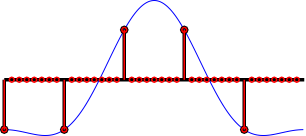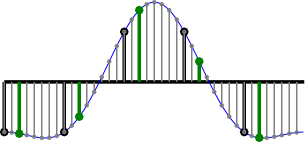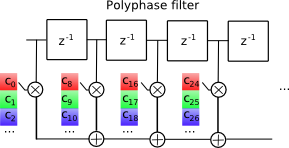Polyphase filter / Farrows interpolation
Hello,
this article is meant to give a quick overview over polyphase filtering and Farrows interpolation.
A good reference with more depth is for example Fred Harris' paper: http://www.signumconcepts.com/IP_center/paper018.pdf
The task is as follows:
Interpolate a band-limited discrete-time signal at a variable offset between samples.
In other words:
Delay the signal by a given amount with sub-sample accuracy.
Both mean the same.
The picture below shows samples (black) representing a continuous-time waveform (blue).

Conceptually, the problem is "easy" to solve:
Reconstruct the continuous-time waveform from the samples,
then
resample as desired
Ideal reconstruction of the blue curve requires an ideal lowpass filter. It can be approximated by a FIR filter to any desired accuracy (but the better the filter, the more latency is introduced to the system).
Another approximation can be made: Instead of delaying the signal in arbitrary small steps, it may be sufficient to limit the accuracy to a fraction 1/N of a sample. In my example I'm using 1/8.
This limitation will be lifted at the end, when the polyphase filter is developed into the Farrows interpolator.
Accordingly, the task is now:
Interpolate the signal by a factor of N (in the example 8)
and
decimate with an offset according to the delay, also called "decimation phase".
Interpolation is done by inserting zero samples... (picture)

... and lowpass-filtering (picture).

Out of N samples, the one with the desired offset is now picked out. The other N-1 samples are discarded by decimation.
For example: decimation for a 1/8 offset, only the red samples 'survive':

Alternative decimation phase: Delay 2/8 samples, the green samples are of interest:

Another decimation phase for 3/8 samples delay (blue samples)

A possible FIR filter implementing the lowpass and decimation is shown below:
For the 1/8 delay case, only the red taps are nonzero, the other samples are discarded (decimated):
Delay by 2/8 uses only the green taps, delay by 3/8 only the blue taps and so on.

A real FIR filter designed to typical requirements (most notably passband ripple, alias rejection, width of the transition region), may easily require 100 taps or more. It will be much longer than shown.
Of course, an implementation according to above picture would be very inefficient, since most parts of the filter aren't doing anything (not contributing to the output).
This can be seen in the following picture, showing the same filter with all "decimated" branches removed.

Only one out of 8 taps is nonzero. Also, N-1 zero samples are created at the input for every actual sample, and they cannot contribute to the output.
As a result, the filter can be simplified, and the N-1 zero samples per input sample are omitted.
The picture below shows three filters for different decimation phase, delaying the signal by 1/8, 2/8 or 3/8 of a sample, respectively.

Note that in comparison to the full-length FIR filter, the length has shrunk by a factor of N (8 in the example). Only one of the above filters is needed at a time. So one filter is sufficient, with N banks of coefficients that are selected by a "commutator switch".

Even though the number of delays and multipliers has been reduced, the total number of coefficients remains the same as in the original filter.
The higher the required subsample accuracy N, the more coefficients are needed.
Instead of stacking more and more coefficients for each multiplier, it is possible to fit one polynomial to the series of coefficients for each multiplier. Its variable is the desired subsample delay, corresponding to the position of the commutator switch in the above picture.
The Farrows interpolator replaces each column of coefficients with a polynomial.
So much for now...
I hope the material has been useful to give some overview on the topic.
If you have comments or questions, please reply to the blog or send me a mail.
Especially "bug reports" are always welcome.
And thanks for reading!
Cheers
Markus
Another free reference: http://www.acoustics.hut.fi/~vpv/publications/icassp00-fd.pdf
PS: Be careful with using equiripple filter designs (Parks McClellan) for Farrows scheme.
The outermost points of the impulse response do not form a "smooth" curve. They are a discontinuity and cannot be easily approximated by a polynomial.
This issue does not appear with a simple polyphase implementation of the same filter.
Some related code snippets:
Determining the delay between two given signals and resampling
Farrow resampler implementation in plain Matlab (vectorized, no toolboxes)
Farrow resampler implementation in C (sample-by-sample)
Ideal resampling at arbitrary time instants
Bank-switched Farrow resampler: (documented here): Fewer multiplications at the expense of more coefficients
- Comments
- Write a Comment Select to add a comment



Tank you for this article.
The reference cannot be reached. Can you present the full title of the paper so that I can download it from the Internet? Thanks in advance


this technique is valid for interpolation, but for the decimation as you progress ?
Is possible to have the code "C" for decimation ?
I appreciate your help !!!
debugasm

looking at the math, interpolation and decimation are the same: "m" input samples generate "n" output samples, the conversion ratio is n/m regardless of which one is greater.
A useful generic C implementation is somewhat difficult as it depends heavily on its surroundings (i.e. block processing).
For example, you can find example "C" code (a 256-bank polyphase using Catmull-Rom splines) in the open source project "fluidsynth" in the dsp/voice routines. For audio, this can work fairly well.
I've got some _RTL_ code for a polyphase resampler that does both interpolation and decimation, here:
http://www.dsprelated.com/showarticle/198.php
To post reply to a comment, click on the 'reply' button attached to each comment. To post a new comment (not a reply to a comment) check out the 'Write a Comment' tab at the top of the comments.
Please login (on the right) if you already have an account on this platform.
Otherwise, please use this form to register (free) an join one of the largest online community for Electrical/Embedded/DSP/FPGA/ML engineers:


















